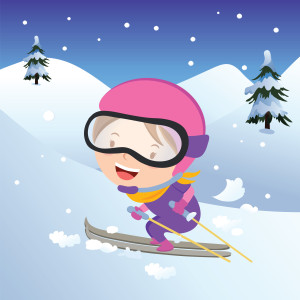Winter has begun and many people in cooler climates are welcoming the start of ski season. While it’s fair to say that we’ve become increasingly aware of the severe consequences of a head injury and realize it’s not as simple as an event that occurs and someone has a headache for a few days, you probably didn’t know skiing is rated as one of the top five sports that lands Canadians in the hospital. Children are at the highest risk of sustaining a concussion while skiing.
Statistics from the Canadian Pediatric Society back this up:
– Among young skiers, 40% – 50% of injuries occur to beginners, often on the first day of skiing.
– Head injuries account for the majority of deaths, serious injuries and significant disabilities sustained while skiing and snowboarding.
– Among skiers younger than 13 years of age, children using rented equipment were more likely to be injured than children using their own equipment.
Adults play an important role in influencing and modelling the right behaviors when it comes to being safe on the slopes and in other winter activities. While injury prevention should be a goal we all aspire to attain, it’s especially important with children as the brain does not fully develop until the early 20’s, meaning youth can experience a concussion and may not show cognitive impairment until a few years later once the injured area of the brain has developed.

Five tips to lower the chances of children getting a concussion this winter:
1. Make sure all equipment fits properly. This includes both footwear (winter boots, ski boots, skates, etc.) and headgear. Tips on how to choose the right helmet and ensure a proper fit can be found at www.skicanada.org. It’s important to note helmets are not universal so for optimal protection you’ll want to have the proper helmet for the right sport (i.e. a cycling helmet is not an effective measure of protection when skiing).
2. Enroll your children in age appropriate group or one on one lessons so they can master the right technique (skiing, skating, snowboarding, snowmobiling, etc.)
3. Helmets are not just for skiing or skating! Put a lid on it whenever there is potential risk of a fall (i.e. tobogganing, sledding, etc.)
4. Always take notice of any potential dangers whenever your children are taking part in winter sports and make adjustments as needed (i.e. if sledding, assess the landscape to ensure there are no stumps or other obstacles on the pathway that could cause a crash).
5. Establish a buddy system with one or more of their friends and have them look out for one another. Children younger than eight years of age should always be well supervised outside.
Another way to open the channel of communication between children and adults is as simple as picking up a copy of Emma’s Skiing Adventure where Emma takes the reader on a journey down the ski hill, where she collides with two bunnies. After the accident, they share an important message with her about wearing a helmet while skiing. Emma’s Skiing Adventure ,weaves a short yet compelling story, mixed with a bit of humour to make this message approachable for young children and their caregivers.
Emma has more tips on staying safe on the slopes and how best to use a helmet and this children’s book is sold at fine online retail outlets that include Indigo, Amazon and Barnes and Noble. You can read testimonials of what people have to say about Emma’s tips here.
What suggestions do you have on lowering children’s chances of getting concussions?












Leave a Comment